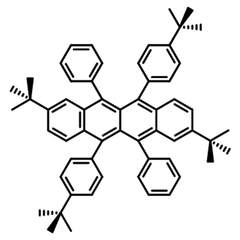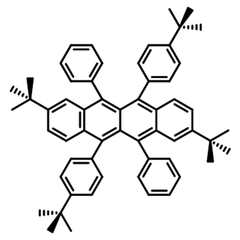TBRb
CAS Number 682806-51-5
Dopant Materials, High Purity Sublimed Materials, Semiconducting Molecules, TADF Materials
TBRb, yellow dopant material in TADF-OLEDs
High purity dopant used to improve device performance
A family member of tetracene, 2,8-Di-tert-butyl-5,11-bis(4-tert-butylphenyl)-6,12-diphenyltetracene (TBRb) has been widely used as a yellow dopant material in TADF-OLEDs. It is popular because of its bipolar characteristics.
The greater hindrance introduced by four tetra-tert-butyl bulky steric groups (attached to the benzene rings of rubrene) is believed to reduce the chances of concentration-quenching by effectively preventing inter-molecular aggregation of the dopant molecules. In return, this can improve device performance (e.g. in terms of external quantum efficiencies, overall power efficiencies, and lifetime).
General Information
| CAS number | 682806-51-5 |
|---|---|
| Full name | 2,8-Di-tert-butyl-5,11-bis(4-tert-butylphenyl)-6,12-diphenyltetracene |
| Chemical formula | C58H60 |
| Molecular weight | 757.1 g/mol |
| Absorption | λmax 306 nm in DCM |
| Fluorescence | λem 571 nm in DCM |
| HOMO/LUMO | HOMO 5.38 eV, LUMO 3.20 eV [1] |
| Synonyms | Tetra(t-butyl)rubrene, 2,8-di(t-butyl)-5,11-di[4-(t-butyl)phenyl]-6,12-diphenylnaphthacene |
| Classification / Family | Tetracene derivatives, Organic electronics, TADF-OLEDs, TADF yellow dopant materials, Sublimed materials. |
Product Details
| Purity | Sublimed >99.0% (HPLC) |
|---|---|
| Melting point | TGA: >310 °C (0.5% weight loss) |
| Appearance | Orange powder/crystals |
*Sublimation is a technique used to obtain ultra pure-grade chemicals. For more details about sublimation, please refer to the Sublimed Materials.
Chemical Structure

Device Structure(s)
| Device structure | ITO (120 nm)/PEDOT:PSS (60 nm)/TAPC (10 nm)/TCTA (10 nm)/mCP (10 nm)/DPEPO:DMAC-DPS:TBRb (25 nm)/TSPO1 (5 nm)/TPBI (30 nm)/LiF (1 nm)/Al (200 nm) [2] |
|---|---|
| Colour | White |
| Max Current Efficiency | 39.3 cd/A |
| Max EQE | 17.6% |
| Max. Power Efficiency | 41.0 lm W-1 |
| Device structure | ITO/TAPC (75 nm)/TCTA (10 nm)/ Ir(ppy)2tmd+TBRb (30 nm)/B4PYMPM (50 nm)/LiF (0.7 nm)/Al (100 nm) [3] |
|---|---|
| Colour | Yellow |
| Max EQE | 26.1% |
| Max. Power Efficiency | 114.3 lm W-1 |
| Device structure | ITO (120 nm)/PEDOT:PSS (60 nm)/mCP (30 nm)/ CzAcSF:TBPe:TBRb (25 nm)/TSPO1 (5 nm)/TPBI (30 nm)/LiF (1 nm)/Al (200 nm) [4] |
|---|---|
| Colour | White |
| Max Current Efficiency | 35.1 cd/A |
| Max EQE | 14.0% |
| Max. Power Efficiency | 36.2 lm W-1 |
| Device structure | ITO (95 nm)/HATCN (10 nm)/ TAPC (45 nm)/TCTA (5 nm)/0.4 wt% TBRb: 6 wt% 4CzPN (8 nm)/0.8 wt% TBRb: 10 wt% 4CzPN: mCBP (4 nm)/40 wt% Bepp2: mCBP (5 nm)/Bepp2 (3 nm)/5 wt% DSA-Ph*: MADN (8 nm)/TmPyPB (50 nm)/LiF (1 nm)/Al (100 nm) [5] |
|---|---|
| Colour | White |
| Max Current Efficiency | 48.9 cd/A |
| Max EQE | 15.1% |
| Max. Power Efficiency | 47.4 lm W-1 |
*For chemical structure information, please refer to the cited references
Pricing
| Grade | Order Code | Quantity | Price |
|---|---|---|---|
| Sublimed (>99.0% purity) | M2125A1 | 250 mg | £260 |
| Sublimed (>99.0% purity) | M2125A1 | 500 mg | £420 |
| Sublimed (>99.0% purity) | M2125A1 | 1 g | £700 |
MSDS Documentation
Literature and Reviews
- Highly efficient yellow and white organic electroluminescent devices doped with 2,8-di(t-butyl)-5,11-di[4-(t-butyl)phenyl]-6,12 diphenylnaphthacene, T-H. Liu et al., Appl. Phys. Lett. 85, 4304 (2004); doi: 10.1063/1.1803911.
- High efficiency fluorescent white organic light-emitting diodes having a yellow fluorescent emitter sensitized by a blue thermally activated delayed fluorescent emitter, W. Song et al., Org. Electron., 23, 138–143 (2015); doi: 10.1016/j.orgel.2015.04.016.
- Highly Efficient, Conventional, Fluorescent Organic Light-Emitting Diodes with Extended Lifetime, H. Kim et al., Adv. Mater., 29, 1702159 (2017); DOI: 10.1002/adma.201702159.

 TBRb MSDS sheet
TBRb MSDS sheet